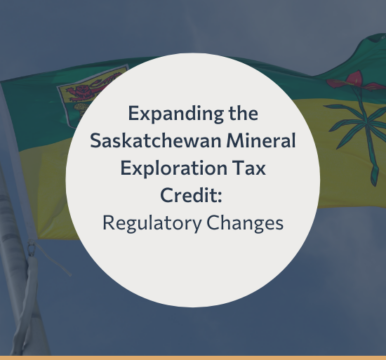On April 7, 2022, the Federal Finance Minister Chrystia Freeland tabled her second budget which included a new 30% Critical Mineral Exploration Tax Credit (“CMETC”) for exploration expenditures renounced to flow-through share investors with respect to fifteen specified minerals. It is important to note that the CMETC is only available in conjunction with an offering for common shares designated as flow-through shares.
The CMETC is a five-year incentive on financings closed by March 31, 2027 relating to exploration programs for nickel, cobalt, lithium, graphite, copper, rare earth elements, vanadium, tellurium, gallium, scandium, titanium, magnesium, zinc, platinum group metals or uranium. The minerals in this group play key roles in the production and processing of advanced materials, semiconductors and clean technology, including batteries and permanent magnets used in zero-emission vehicles.
Flow-Through Share Premiums, Tax Risk and Issuer Indemnity Liabilities
As all resource issuers, advisors, and bankers appreciate, a flow-through share is simply a newly issued common share designated by the issuer in the subscription agreement as a flow-through share as defined in the Income Tax Act of Canada (ITA) in which the issuer renounces the exploration expenses in favour of the first subscriber from treasury. For tax purposes, a flow-through share behaves much like a limited partnership unit – the flow-through share subscriber funding new exploration accesses the tax deductions and credits associated with the activity including, if applicable, the newly announced CMETC.
If the issuer fails to spend the funds in accordance with the tax legislation, the flow-through share subscribers – the taxpayers who first deducted the renounced exploration expenses – may be reassessed by the CRA. This point is brought home in Budget 2022 Supplemental Information which states “Any credit provided for ineligible expenditures would be recovered from the flow-through share investor that received the credit.” We are still in the early stages of the new tax incentive, so the investors and the advisors and professionals upon which they rely will be asking questions and conducting diligence to protect against the possible disallowance of the CMETC down the road.
For more than fifty years, the flow-through tax regime has provided most of the exploration capital leading to Canada’s success as a global powerhouse in mining, resource exploration, development, engineering and finance. Simply put, issuers exploring in Canada irrespective of home jurisdiction can flow through tax benefits resulting in less share dilution and reduced investor risk. From the issuer perspective, common shares designated as flow-through shares command an issue price premium to market thus reducing dilution while at the same time, the shareholders’ after-tax risk of investment is reduced. Reduced risk results in greater availability of capital.
A fundamental term in the flow-through share regime, is the issuer tax indemnity contained in every flow-through share subscription agreement. If the issuer fails to properly spend the funds as per the ITA resulting in a flow-through shareholder tax reassessment, then the issuer is obliged to compensate the shareholder for the lost tax benefit.
After more than fifty years, the CRA is very good at flow-through share issuer audit and regularly reassesses flow-through subscribers when, in its view, the funds were improperly spent.
While it is reasonable to expect that flow-through share premiums will increase for financings that fund critical mineral exploration, investors will be looking for comfort that they are not going to be reassessed for the CMETC. Although the CRA will look to investors, investors in turn have a claim for indemnification under the agreement pursuant to which they subscribe for flow-through shares. Flow-through share subscribers and issuers as well as intermediaries share the same interest in ensuring that the CMETC incentive rules are followed.
Quantifying the CMETC Tax Indemnity Amount
The legacy Mineral Exploration Tax Credit of 15% is calculated as 15% of the Canadian Exploration Expenses (CEE). A CEE subscription of $100,000 results in a $15,000 CREDIT against federal taxes otherwise owing. However, the METC (and presumably the CMETC) is added back into income in the year following the subscription. In this case a subscription for $100,000 in 2022 results in a $15,000 METC tax credit in 2022 with $15,000 added back into income in 2023 with tax paid thereon in 2023. The net tax savings in most provinces is about $7,000. The new CMETC is 30%. Assuming that the CMETC is denied by the CRA but otherwise qualifies as METC then the net issuer tax indemnity obligation is roughly 7% of subscription amount.
Issuers who have experienced the CRA denying flow-through expenditures and then suffered through the resultant shareholder angst and claims for tax indemnity, know that the financial burden, countless management hours principally borne by the CFO, negative public disclosure, possibly coupled with the need to raise common share capital to pay the indemnity, makes getting it right at the outset critically important.
Practical Matters
Budget 2022 Supplementary information states “in order for exploration expenses to be eligible for the CMETC, a qualified person (as defined under National Instrument 43-101 published by the Canadian Securities Administrators as of Budget Day) would need to certify that the expenditures that will be renounced will be incurred as part of an exploration project that targets the specified minerals. If the qualified person (QP) cannot demonstrate that there is a reasonable expectation that the minerals targeted by the exploration are primarily specified minerals, then the related exploration expenditures would not be eligible for the CMETC.” In addition, “Eligible expenditures would not benefit from both the proposed CMETC and the METC. The administration of the CMETC would generally follow the rules in place for the METC. However, the CMETC would only apply in relation to exploration expenditures for the minerals listed above.”
Many of the critical minerals in respect of which exploration expenditures would qualify for the CMETC commonly occur in association with minerals not on the Critical Minerals list. This gives rise to some very difficult issues for the QP being asked to certify that the minerals targeted in an exploration program are primarily specified minerals. More detail on this below.
The budget does not require an independent QP. The CRA is entitled to see the QP back up in support of a ‘reasonable expectation that the minerals targeted by the exploration are primarily specified minerals.’ Over the years the CRA and the courts have addressed a number of intention tests in reference to the term ‘reasonable expectation’, notably the cases surrounding deductibility of expenses requiring or perhaps not requiring (depending on which case you read) a ‘reasonable expectation of profit’ (REOP). In other instances, where a certificate confirming certain scientific tax credits resulted in tax savings, it was found that the CRA could look behind the certificate to determine if the certificate was validly issued and deny passive investor tax deductions if not valid.
While it is clear that an inhouse QP is not precluded from issuing the certificate, you can be certain that the CRA will view a non-arms’ length QP with heightened scrutiny and with a heathy degree of skepticism. To avoid potential management angst, we make a number of initial practical suggestions:
- Engage a third-party arms’ length QP including the firm that may have prepared the 43-101 report or resource estimate. If not applicable, the better the QP reputation in the specific mineral and geographic area the greater the credibility with the CRA.
- An issuer may apply to the CRA for a tax ruling confirming the CRA’s position with respect to the tax characterization of exploration activities. While the formal submission is made to the CRA, in fact the review is completed by NRCAN. If the exploration program is planned for the following season six to seven months away then, under current turn around times, there will be ample opportunity to obtain CRA sign off. Having a CRA ruling on the CMETC will also result in a stronger negotiating position when discussing premiums.
- For larger raises, if the exploration period is more than seven months, then consider quantifying the CMETC tax indemnity. If CRA responds with a ruling as expected by the time the last funds are needed then you will know that the spend is onside and, if not, then the exploration ends and the last funds are used to pay the tax indemnity.
A Brief Case Study Fact Pattern: The issuer is conducting a copper exploration program raising $20M in Q2 2022 in a flow-through share offering where the premium reflects the availability of the critical mineral tax credit. The exploration program contemplates $10M spent in 2022 with the balance in 2023 as allowed by the ITA look-back rule. After spending $10M the drill results show gold intersections with value far greater than the copper value. Are further expenditures eligible for the CMETC? Since the budget documents stated that a QP must be able to demonstrate that there is a reasonable expectation that the minerals targeted by the exploration are primarily specified minerals, it appears that the test for eligibility is prospective and that it is the intention and the reasonableness of that intention at the time a financing is conducted that should be the basis for eligibility. Who has the ultimate, final say on eligibility?
One would expect that if a QP can show appropriate back-up for the conclusion reached at the time the certification was made that the subscribers for flow-through shares to finance exploration for critical minerals would be entitled to the CMETC. On this basis, one would not expect that the CRA would over-rule a QP based upon results after discovery. However, hindsight may not be the best lens through which to assess the reasonableness of a determination made at the outset of an exploration program. That said, the prudent approach would be for the issuer to commission a new QP Certificate referencing the first phase results and, if still the case, the reasons why in the QP’s professional view there remains a ‘reasonable expectation that the minerals targeted by the exploration are primarily specified minerals.’
Prior to the budget, we had learned that federal Finance bureaucrats and presumably the CRA were reluctant to endorse the enhanced CMETC for fear of abuse. This may explain why only 15 critical minerals were listed in Budget 2022 whereas in 2021 NRCAN’s published list of Canada’s critical minerals totalled 31 including chromium (Ring of Fire) and potash. While abuse is unlikely, legitimate disputes will happen. These issues will be addressed and understood over the coming years. We understand PDAC is actively discussing these issues with the CRA and NRCAN.
Raising Questions on Eligibility – More questions than answers
Geology is complex and minerals often occur in assemblages or suites.
Common associations are:
- Copper/Lead/Zinc/Gold/Silver in Volcanogenic Massive Sulphide Deposits
- Zinc/Lead in Mississippi Valley Deposits
- Silver/Cobalt
- Nickel/Platinum/Palladium/Cobalt
- Lithium/Caesium/Tantalum/Niobium
- Copper/Gold in Porphyritic Deposits
- Tellurium/Gold
- Scandium/Tin/Tungsten
- Gallium/Aluminum
The new CMETC eligibility relies on a QP, to certify that the work targets a critical mineral. It would be relatively simple for a QP to sign-off on a uranium, graphite or nickel target as these are usually the dominant, or only economic mineral in these types of deposits.
The budget did not suggest how you determine which is the targeted mineral. Is it based on abundance, value or presence? If based on value, this is only ascertained after the exploration is complete, and can change dramatically through time with fluctuations in commodity prices. How does a QP specifically state that a specific mineral is the target and not a by-product?
Lithium deposits in Canada, generally from pegmatites, should easily be defined as the target, although the deposit may also contain economic quantities of caesium, niobium, tantalum, etc., non-critical minerals according to the new budget.
Cobalt, commonly a by-product, may be found with silver, where silver may be the dominant mineral of economic value (e.g. Ontario’s Silver Camp in Cobalt). In these instances, does cobalt become the target and silver the by-product?
VMS Deposits often occur with precious metals and commonly a substantial portion of the value may be derived from the precious metal content. MVT Deposits contain a critical mineral (zinc) and a non-critical mineral (lead). Does targeting a copper-gold porphyry qualify for the additional tax incentive but a gold/copper porphyry does not?
To restate our copper gold fact pattern what happens if you target a copper deposit, but intersect a gold zone? Is this an eligible expense? When does the mineral of target need to be decided? When the flow-through shares are issued, often prior to detailed targeting, or after all the results are in?
How do you define eligible targets on early-stage reconnaissance projects? The company may be exploring for lithium, but stumbles upon a quartz vein with gold. Is the entire exploration program not eligible for the CMETC?
Other Interesting resource provisions taken from Budget 2022 – largely merely quoted…
Supporting Critical Minerals Projects in Canada
Critical mineral mining projects are expensive and come with a unique set of challenges that can often include remote locations, changing prices, and lengthy regulatory processes. Making these projects a less risky undertaking for companies will help grow both Canada’s critical mineral industry and secure the good resource jobs of the future. Specific measures proposed in Budget 2022 to support critical mineral projects include:
- Up to $1.5 billion over seven years, starting in 2023-24, for infrastructure investments that would support the development of the critical minerals supply chains, with a focus on priority deposits
- $79.2 million over five years on a cash basis, starting in 2022-23, for Natural Resources Canada to provide public access to integrated data sets to inform critical mineral exploration and development
One Last Year for Oil, Gas & Coal Flow-Through Share Financings
As promised in the Liberal policy plank prior to the recent federal election, flow-through shares funding oil and gas exploration as well as coal is being phased out. While we expected this provision to be in the current budget, there is a one-year reprieve eliminating flow-through share financings for these resources on financings closed after March 31, 2023. The net economic impact of this change is marginal in the oil and gas sector. Oil and gas issuers that have survived the past three years are profitable. With the current price of oil, the tax pool value to the issuer is greater than a flow-through premium.
Like all budgets, Budget 2022 is not fully baked legislation. Yet issuers, investors and intermediaries (and government) are all keen to see expanded critical mineral exploration and discovery.
In conclusion
For over 50 years, the flow-through share regime has proven to be a fiscally fair and efficient way to drive rapid job creation in northern communities. Capital raised in this format can only have one purpose – deploying labour in exploration teams looking for mineral resources. A dollar of investment in flow-through shares by urban investors (and a dollar of tax deduction) is a dollar deployed in northern jobs (and a dollar of taxable income in the north). If the resource company fails to spend the funds – mostly labour – then the investors are denied the flow-through deductions.
Unlike government incentives such as film and Scientific Research and Experimental Credits (SHRED), requiring application, approval and receipt of a government cheque often not paid until years after the funds are spent, in the flow-through regime there is no red tape. As long as the rules set out in the ITA are followed then investment decisions are democratically driven by the market participants. The CRA is not the gatekeeper, it’s not the processing bottleneck, it’s merely the umpire. Current activity results in current tax savings for investors. Issuers that fail to meet the ITA requirements pay the indemnities and management is penalized.
Holistically, the flow-through regime is an elegant arrangement in which high net worth urban investors take on venture capital investment risk with the use of funds directly linked to northern job creation. And unlike any other sector, while ownership may change, the mine, the jobs and tax paid to the fiscal authority remain in Canada.
Every department of Finance, and Canada is no different, abhor tax incentives. For more than a decade we have advocated for evidence-based tax policy in support of the flow-through regime. For example, see this special report.
Those in this sector know that the CMETC will increase exploration for critical minerals. It is our hope that this new incentive is quickly, properly and broadly adopted and that the economic impact is so obvious to politicians and bureaucrats alike that within a year or two, the CMETC is expanded to include all 31 critical minerals including chromium in support of the Ring of Fire, and potash in support of global food supply.








